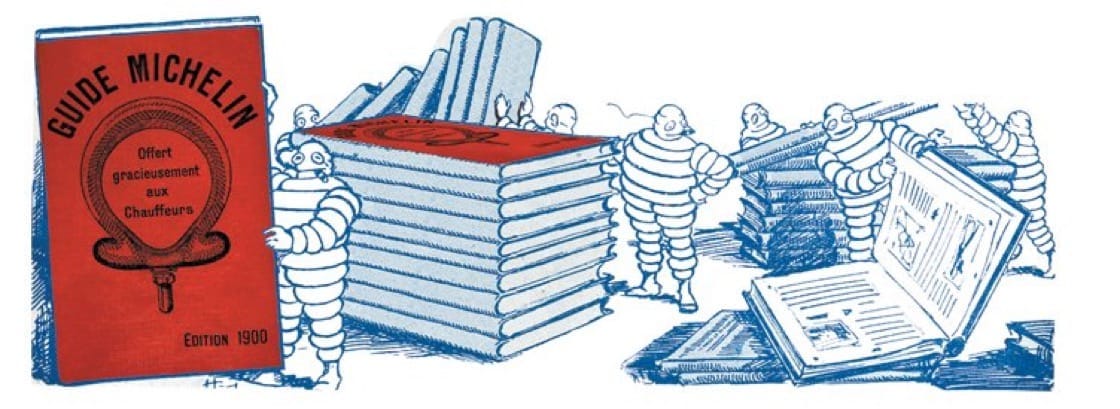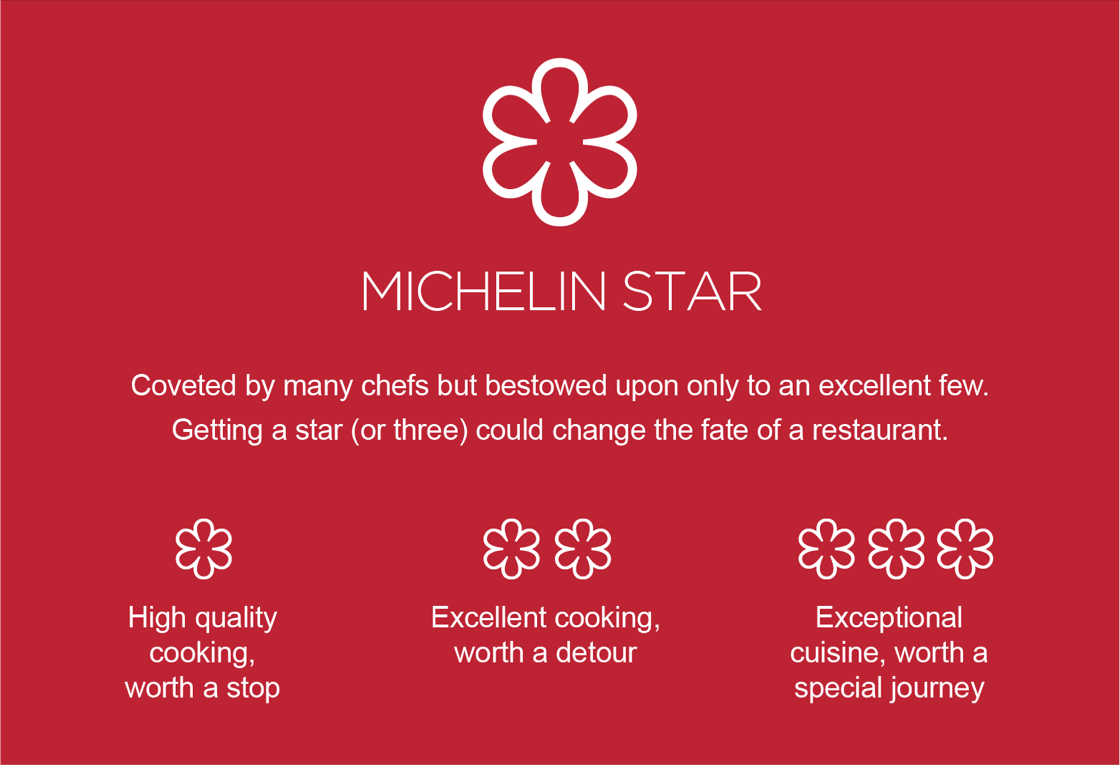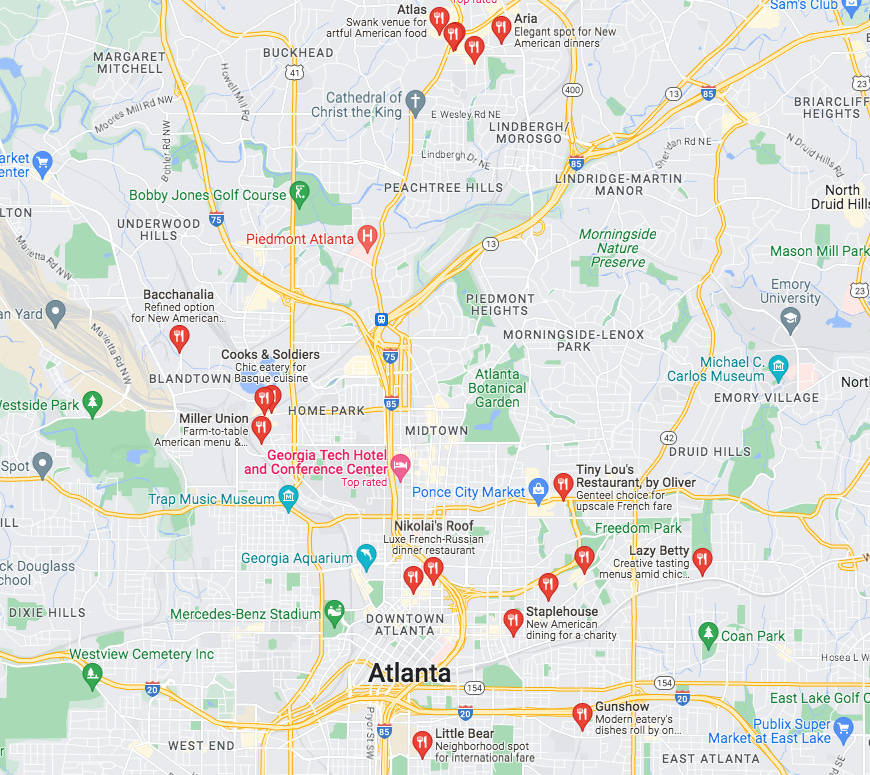The Atlanta Michelin guide debuts, but does it matter? - Part One
Atlanta is taking a culinary step forward but does it matter?
Welcome to my newsletter by me, King Williams. A documentary filmmaker, journalist, podcast host, and author based in Atlanta, Georgia. This is a newsletter covering the hidden connections of Atlanta and everything else.
New Podcast: Reactions to the Atlanta Michelin Guide with Sara Delgado
Sara Delgado returns to give her thoughts on the 2023 Atlanta Michelin Guide. The guide comes at a time when Atlanta's food scene is being heavily questioned on both its quality and service. In addition, social media influencer Keith Lee is in town tasting Atlanta's Black-owned restaurants, resulting in an online firestorm of virality.
This episode is available on Apple Podcasts, Spotify, and Substack!
Part 1: Does Atlanta’s restaurant scene have what it takes to get a Michelin star? - Featuring Sara Delgado
The Michelin Guide is in Atlanta
The Michelin Guide, the world’s most prestigious ranking of restaurants, is currently dining in Atlanta in anticipation of the city’s first Michelin Guide release. But in the age of Yelp, Instagram, YouTube, food influencers, and virality, what (if any) impact does the Michelin Guide have on Atlanta’s restaurant scene?
1. What is the Michelin Guide?
The Michelin Guide is a travel guide for tourists. It was started in France in 1900 by the Michelin Tire Company as a promotional vehicle. The company believed that the guidebook would serve as a lead magnet for the small but growing fleet of personal cars arriving on the roads of France for the first time. Cars that would be using Michelin tires.
Within ten years, the company would produce guidebooks for other countries, including Italy, Switzerland, Bavaria, Germany, Spain, Portugal, Algeria, Tunisia, and the Netherlands. The guide would continue its growth until World War I, picking up again in 1920 after the war concluded.
For the first two decades, the guide was free for customers until 1922, when the company decided to pivot the free guide into a paid guide. This was followed by additional changes to the guide to feature restaurants by specific categories, removing advertisements, adding hotel listings, and, in 1926, its biggest change, the introduction of the review system.
The Michelin Star’s beginnings
The review system of the Michelin guide borrowed its system from the British review guide Murray’s Handbooks for Travelers and the German review guide Baedeker Guides, both of which began in the 1830s. The Michelin guide pulled from both in differing ways.
From the Baedeker Guide, The Michelin Guide adopted the detailed, no-punches-spared style of review that is now customary to top food criticism today. From Murray’s Handbooks for Travelers, The Michelin Guide adopted the personal travel essay style of review.
What do the Michelin Stars mean?
The review system evolved from a single-star review in 1926 to a review system ranging from zero, one, two, and three stars in 1931. The process still influences other restaurant and food-based reviews to this day. In 1936, the criteria for Michelin-star restaurants were first published.
What each star means, via the company’s website:
One Star — ‘awarded to restaurants using top quality ingredients, where dishes with distinct flavours are prepared to a consistently high standard.
Two Stars — ‘are awarded when the personality and talent of the chef are evident in their expertly crafted dishes; their food is refined and inspired.’
Three Stars — ‘our highest award, given for the superlative cooking of chefs at the peak of their profession; their cooking is elevated to an art form and some of their dishes are destined to become classics.’
The other Michelin awards:
Bib Gourmand — ‘our best value for money restaurants – offering a three-course meal at a reasonable price’
The Michelin Plate — Introduced in 2017, this is given to a restaurant that didn’t qualify for a star or Bib Gourmand but is worth praising.
Green Star — The newest star award that the company introduced in 2020, focusing on restaurants focused on sustainability.
Note that not every restaurant receives a star. Restaurants can also gain or lose stars if the quality goes down or up. Some Zero Star restaurants can also be given a special recognition by the guide. Restaurants can also be mentioned as being recommended as well.
2. Why is the Michelin Guide important?
The Michelin Guide is the highest restaurant rating system in the world. With it comes accolades, awareness, and acclaim unlike anything in the food world. It’s the Oscars for food.
The Michelin Guide is the hallmark of fine dining, awarding chef-driven kitchens and top craftsmanship. Due to the guide’s history and propensity to focus heavily on fine dining, innovation, and excellent service have become the benchmark for the world’s best.
It attracts the likes of the world’s best food reviewers, wealthy individuals, and would-be travelers to these restaurants. Due to the secretive nature of the review process, past winners, and demand for inclusion by municipalities across the globe, the guide has a prestige all its own.
How reviews are conducted
Michelin reviews are done in secret. Typically ranging from one or more years, this review system allows for Michelin reviewers to try a variety of restaurants and hotels.
Michelin reviewers undergo a training process to avoid detection, including how not to tell their loved ones and friends what they do for work.
What does/doesn’t get reviewed
Michelin typically avoids chain restaurants of all varieties: sit-down (Chili’s, Applebees), fast casual (Chipotle, Panera), and quick-serve (McDonald’s, Chick-fil-A). It also typically (but not always) avoids restaurants that serve foods using mass-produced items such as processed foods.
What are the criteria for a Michelin Star restaurant?
The guide weighs heavily on locally sourced, natural ingredients and handmade items. It also weighs heavily on the execution, presentation, service, quality of food, and delivery.
What restaurants are likely to be awarded a Michelin Star?
While it’s hard to speculate what restaurants will be given a Michelin Star, it is possible to see what types of restaurants have been awarded in the past. Michelin restaurants are typically fine dining or high execution-based, meaning most mass-produced restaurants or restaurants serving mass-produced foods are left out. So, most quick-to-serve restaurants (fast food/gas station/fast casual) and chain restaurants are left out.
3. Why would Atlanta want to join the Michelin review system?
For a city like Atlanta, having the Michelin review guide in town for the next three years provides an opportunity to highlight the best and brightest. It is another branding opportunity and a way to separate the city from a growing list of regional food scene competitors—cities such as Charlotte, Charleston, Savannah, Nashville, Louisville, and New Orleans.
Is Atlanta’s food scene even on the level of Michelin
In short, yes-ish. But the quantity, geography, and general awareness are relative. In addition to the understanding of the nuances of fine dining.
Are Atlanta diners sophisticated enough for Michelin?
Yes. But this question and the attitudes accompanying it reflect a general slight and reality of the marketplace. In Atlanta, a metro area defined by its lack of refinement, chain restaurants of every variety, a uniform food scene, and a tendency to follow trends versus making them, there is a tendency for a lot of food criticism to arise from generations of people who have never actually had the experience fine dining, chef-driven menus, nor developed the palates (cultural exposure) ‘necessary’ to critique food.
Fine Dining versus Casual Dining
Fine Dining
Fine dining is not the same as casual dining. Fine dining can be misconstrued as any restaurant with a tablecloth and silverware. Fine dining is not without a bit of deserved and undeserved snobbery attached.
Casual Dining
Casual dining is defined by the lack of rules, including clothing requirements, music preferences, and menus. Casual dining has grown and expanded in numerous ways. Fast food, fast casual, chain restaurants, food halls, cafeterias, and diners could all be considered casual dining.
4. Which Atlanta-area restaurants were awarded a Michelin Star?
There were some surprises. But overall, the list is mostly expected from many Atlanta area foodies. Most of the list was fine dining but with a few sit-down well-known comfort food restaurants.
The winners
This year saw the inclusion of 5 one star level restaurants in the guide:
Atlas - American, Buckhead (West Paces Ferry)
Hayakawa - Japanese, Westside (Howell Mill)
Lazy Betty - American, Candler Park
Mujō - Japanese, Westside (Northside and 14th St)
Bacchanalia - American, Westside (Howell Mill)
In all 45 restaurants were selected by Michelin. This includes 5 One-star restaurants, two Green Star restaurants, and ten Bib Gourmand recipients. Additionally, over two dozen restaurants were recommended by Michelin.
For those in the know, the list wasn’t a surprise.
The list comprised many previous award nominees and restaurants, often on several ‘best-of’ lists. They are following chefs and restaurants who’ve already been awarded—following the same pattern of Michelin awardees as other cities. If a chef in the US has been awarded or nominated for a prestigious award such as the James Beard, they will likely also be included in the Michelin Guide.
5. The location of Michelin winners signals a statement of where ‘good food’ is. And, where it isn’t.
The location of those restaurants reviewed signals a statement of where ‘good food’ is. And, where it isn’t. It reflects demographics and cuisine choices, for better or not.
Atlanta has Michelin-quality restaurants. Those restaurants are likely also in wealthier residential enclaves and commercial districts. Leading to an unsaid reality, perceived or otherwise, of where high-quality food is or isn’t.
The location of a Michelin-star restaurant also signals economic vitality and/or growth. Michelin typically reviews restaurants of high standards and high quality, typically in business districts, tourist districts, and wealthy neighborhoods on clays.
Where in the metro is fine dining?
Buckhead, Midtown, and Decatur won big based on the first round of winners. Unsurprisingly, all three metro sections have had numerous successful chefs and restaurants. These sections and those surrounding them reflect the demographic reality of dining in Atlanta. Many chefs have built out a more sustainable and notable presence within these areas.
Metro Atlanta cities/neighborhoods likely to have restaurants reviewed for a Michelin Star now or in the future:
Atlanta: Buckhead, Midtown, Howell Mill corridor, Marietta Blvd-Chattahoochee Avenue, Inman Park, Reynoldstown, Cabbagetown, Virginia Highlands-Poncey Highland, East Atlanta, Old Fourth Ward, Candler Park, Grant Park-Summerhill, Kirkwood, Druid Hills-Emory, Morningside, Edgewood, and Hapeville.
North Fulton: Milton, Alpharetta, Johns Creek, Roswell, and Sandy Springs.
South Fulton: Mainstreet, College Park-East Point, and Chattahoochee Hills.
North/Central DeKalb: Brookhaven, Dunwoody, Chamblee, Emory, Downtown Decatur, Avondale Estates, Tucker, and Clarkston.
Cobb: Vinings, Smyrna, Cumberland, Kennesaw, and Ackworth
Gwinnett: Western/Northwest corridor—Norcross, Peachtree Corners, Duluth, Suwanne, and Buford. Also, Lawrenceville, Dacula, Snellville
The location of a Michelin-star restaurant is also a signal of economic vitality and/or growth. Michelin typically reviews restaurants in wealthier neighborhoods, business districts, and retail corridors. While not limited to those spaces, the guide is overall a reflection of those tastes, whether intentional or not.
There were no OTP restaurants included in the first round.
There were no OTP restaurants included in the first round of Michelin awards. This could be a product of management as neighboring wealthier enclaves such as Roswell, Milton, Johns Creek, Alpharetta, Sandy Springs, Dunwoody-Perimeter, Kennesaw, and Marietta were noticeably absent. Considering Michelin stated this was both the first round of awards and the company plans on reviewing until 2025, it is more efficient to start ITP.
Considering the size and suburban sprawl, the would-be distances traveled amongst the big 5 core counties: DeKalb, Fulton, Cobb, Gwinnett, and Clayton. It could be a while before most of the metro is covered by Michelin.
6. Michelin isn’t the only review, but it is the most important
Michelin isn’t the only review guide, but since its arrival over a century ago, it remains the most important. There are several other awards, including the American restaurant industry’s highest honor, the James Beard Award.
There are tons of reviews, guides, and awards ranging from Zagat ratings, AA Hospitality Awards, World’s 50 Best Restaurants, Gault & Millau, and The New York Times all hold a level of importance. Even sparkling water company San Pellegrino has its own 50 best restaurants list. While locally, Eater Atlanta, Atlanta Magazine, and the AJC often produce food-related lists and recommendations.
The audiences for Michelin are not the same for online-centered dining
In this day and age, The Michelin Star system, along with other prestigious awards, has fallen in prominence and influence. To a great degree because of the rise of Youtube, Instagram influencers, TikTok trendy menus, pop-up restaurants, food shock culture, podcasts, DoorDash, Yelp, and Twitter/X.
The gatekeepers of good food were slowly changing, and then the internet happened.
This also coincides with a continual emphasis on print-based journalism as the arbiter of culture and critique. Starting in the 1950s with Julia Child, whose breakthrough program started the modern TV food program.
This continued into the 1990s with the proliferation of cable television, particularly with the start of the Food Network. They were combined with the late 1990s/early 2000s rise of broadband internet, leading to greater access to online food recipes, criticism, and voices. From websites, blogs, chat rooms, and online marketplaces, the notion of who had a voice in food changed. Slowly, the world of online food, especially food criticism, grew.
By the 2010s, the growth of social media had seen an explosion of people outside of the traditional spaces of influence from previous eras’ mediums. Both experienced chefs, veteran critics, and restauranteurs were suddenly on the same level of awareness as novices, leading to today's paradigm.
7. How much weight does a Michelin Star hold in the age of YouTube, podcasts, and social media?
The Michelin Star system and other prestigious awards have fallen in prominence and influence due largely to an expansion of access, awareness, and new entries in the restaurant space enabled by the rise of the internet.
For decades, Fine dining has been gatekept through geography, awareness of restaurants, pricepoint, and knowledge of how and where to eat have mostly left people locked out. But with the rise of Instagram influencers, TikTok trendy menus, pop-up restaurants, food shock culture, podcasts, DoorDash, Yelp, and YouTube, everyone can access the same marketplace. As a result, fine dining has been replicated, deconstructed, destroyed, and critiqued by those with and without the knowledge of dining. Everyone is a critic now.
This also coincides with the explosion of food media online. 3-star restaurants compete for screentime and reviews alongside chains, local favs, and brand-new restaurants. A good review from a popular influencer does more to drive traffic and reputation for a restaurant than any Michelin star, Eater Atlanta, AJC, Atlanta Magazine, Atlanta Eats, or New York Times review.
Tomorrow: “Grass Wall Restaurants,” Keith Lee reviews, and the backlash to the perception of Black Atlanta Cuisine
Atlanta IS a food town, Michelin Guide or not!
-KJW






